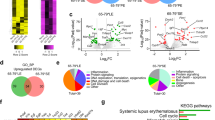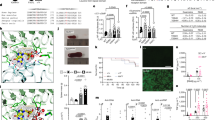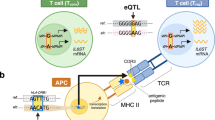Abstract
Lupus susceptibility loci on chromosome 1 have an important role in the development of autoimmunity in the New Zealand Black (NZB) mouse. We have previously shown that C57BL/6 congenic mice with an introgressed homozygous NZB chromosome 1 interval extending from ∼35 to 106 cM develop anti-nuclear antibodies and mild glomerulonephritis. In this study, we produced subcongenic mouse strains to localize the susceptibility loci in this interval and investigate how they promote autoimmunity. Our results indicate at least four susceptibility alleles and a suppressor allele. One allele is located in the 96–100 cM region and is sufficient to breach tolerance to chromatin. Addition of a second locus in the 88–96 cM interval enhances anti-dsDNA antibody production and promotes renal disease, which together with a third susceptibility allele in the 70–88 interval results in significant mortality. We further demonstrate the presence of a suppressor locus in the 35–70 or 100–102 cM interval that abrogates these phenotypes and an additional susceptibility allele in the 102–106 cM interval that restores a milder autoimmune phenotype. Several of these loci alter T-cell function. Thus, there is substantial genetic complexity in the NZB 35–106 cM interval, with disease reflecting a balance between susceptibility and suppressor loci.
This is a preview of subscription content, access via your institution
Access options
Subscribe to this journal
Receive 6 digital issues and online access to articles
$119.00 per year
only $19.83 per issue
Buy this article
- Purchase on Springer Link
- Instant access to full article PDF
Prices may be subject to local taxes which are calculated during checkout







Similar content being viewed by others
References
Sherer Y, Gorstein A, Fritzler MJ, Shoenfeld Y . Autoantibody explosion in systemic lupus erythematosus: more than 100 different antibodies found in SLE patients. Semin Arthritis Rheum 2004; 34: 501–537.
Sawalha AH, Harley JB . Antinuclear autoantibodies in systemic lupus erythematosus. Curr Opin Rheumatol 2004; 16: 534–540.
Burlingame RW, Boey ML, Starkebaum G, Rubin RL . The central role of chromatin in autoimmune responses to histones and DNA in systemic lupus erythematosus. J Clin Invest 1994; 94: 184–192.
Theofilopoulos AN, Dixon FJ . Murine models of systemic lupus erythematosus. Adv Immunol 1985; 37: 269–390.
Chiang BL, Bearer E, Ansari A, Dorshkind K, Gershwin ME . The BM12 mutation and autoantibodies to dsDNA in NZB.H-2bm12 mice. J Immunol 1990; 145: 94–101.
Wither JE, Lajoie G, Heinrichs S, Cai YC, Chang N, Ciofani A et al. Functional dissection of lupus susceptibility loci on the New Zealand black mouse chromosome 1: evidence for independent genetic loci affecting T and B cell activation. J Immunol 2003; 171: 1697–1706.
Cheung YH, Chang NH, Cai YC, Bonventi G, MacLeod R, Wither JE . Functional interplay between intrinsic B and T cell defects leads to amplification of autoimmune disease in New Zealand black chromosome 1 congenic mice. J Immunol 2005; 175: 8154–8164.
Xiu Y, Nakamura K, Abe M, Li N, Wen XS, Jiang Y et al. Transcriptional regulation of Fcgr2b gene by polymorphic promoter region and its contribution to humoral immune responses. J Immunol 2002; 169: 4340–4346.
Wandstrat AE, Nguyen C, Limaye N, Chan AY, Subramanian S, Tian XH et al. Association of extensive polymorphisms in the SLAM/CD2 gene cluster with murine lupus. Immunity 2004; 21: 769–780.
Rozzo SJ, Allard JD, Choubey D, Vyse TJ, Izui S, Peltz G et al. Evidence for an interferon-inducible gene, Ifi202, in the susceptibility to systemic lupus. Immunity 2001; 15: 435–443.
Jiang Y, Hirose S, Sanokawa-Akakura R, Abe M, Mi X, Li N et al. Genetically determined aberrant down-regulation of FcgammaRIIB1 in germinal center B cells associated with hyper-IgG and IgG autoantibodies in murine systemic lupus erythematosus. Int Immunol 1999; 11: 1685–1691.
Wither JE, Paterson AD, Vukusic B . Genetic dissection of B cell traits in New Zealand black mice. The expanded population of B cells expressing up-regulated costimulatory molecules shows linkage to Nba2. Eur J Immunol 2000; 30: 356–365.
Szanya V, Ermann J, Taylor C, Holness C, Fathman CG . The subpopulation of CD4+CD25+ splenocytes that delays adoptive transfer of diabetes expresses L-selectin and high levels of CCR7. J Immunol 2002; 169: 2461–2465.
Hori S, Nomura T, Sakaguchi S . Control of regulatory T cell development by the transcription factor Foxp3. Science 2003; 299: 1057–1061.
Cuda CM, Zeumer L, Sobel ES, Croker BP, Morel L . Murine lupus susceptibility locus Sle1a requires the expression of two sub-loci to induce inflammatory T cells. Genes Immun 2010; 11: 542–553.
Liu K, Li QZ, Yu Y, Liang C, Subramanian S, Zeng Z et al. Sle3 and Sle5 can independently couple with Sle1 to mediate severe lupus nephritis. Genes Immun 2007; 8: 634–645.
Morel L, Blenman KR, Croker BP, Wakeland EK . The major murine systemic lupus erythematosus susceptibility locus, Sle1, is a cluster of functionally related genes. Proc Natl Acad Sci USA 2001; 98: 1787–1792.
Vyse TJ, Rozzo SJ, Drake CG, Izui S, Kotzin BL . Control of multiple autoantibodies linked with a lupus nephritis susceptibility locus in New Zealand black mice. J Immunol 1997; 158: 5566–5574.
Howie D, Laroux FS, Morra M, Satoskar AR, Rosas LE, Faubion WA et al. Cutting edge: the SLAM family receptor Ly108 controls T cell and neutrophil functions. J Immunol 2005; 174: 5931–5935.
Wang N, Satoskar A, Faubion W, Howie D, Okamoto S, Feske S et al. The cell surface receptor SLAM controls T cell and macrophage functions. J Exp Med 2004; 199: 1255–1264.
Howie D, Simarro M, Sayos J, Guirado M, Sancho J, Terhorst C . Molecular dissection of the signaling and costimulatory functions of CD150 (SLAM): CD150/SAP binding and CD150-mediated costimulation. Blood 2002; 99: 957–965.
Ma CS, Nichols KE, Tangye SG . Regulation of cellular and humoral immune responses by the SLAM and SAP families of molecules. Annu Rev Immunol 2007; 25: 337–379.
Kumar KR, Li L, Yan M, Bhaskarabhatla M, Mobley AB, Nguyen C et al. Regulation of B cell tolerance by the lupus susceptibility gene Ly108. Science 2006; 312: 1665–1669.
Zhong MC, Veillette A . Control of T lymphocyte signaling by Ly108, a signaling lymphocytic activation molecule family receptor implicated in autoimmunity. J Biol Chem 2008; 283: 19255–19264.
Valdez PA, Wang H, Seshasayee D, van Lookeren CM, Gurney A, Lee WP et al. NTB-A, a new activating receptor in T cells that regulates autoimmune disease. J Biol Chem 2004; 279: 18662–18669.
Jorgensen TN, Alfaro J, Enriquez HL, Jiang C, Loo WM, Atencio S et al. Development of murine lupus involves the combined genetic contribution of the SLAM and FcgammaR intervals within the Nba2 autoimmune susceptibility locus. J Immunol 2010; 184: 775–786.
Chen Y, Cuda C, Morel L . Genetic determination of T cell help in loss of tolerance to nuclear antigens. J Immunol 2005; 174: 7692–7702.
Wang J, Ioan-Facsinay A, van d V, Huizinga TW, Toes RE . Transient expression of FOXP3 in human activated nonregulatory CD4+ T cells. Eur J Immunol 2007; 37: 129–138.
Nishioka T, Shimizu J, Iida R, Yamazaki S, Sakaguchi S . CD4+CD25+Foxp3+ T cells and CD4+CD25−Foxp3+ T cells in aged mice. J Immunol 2006; 176: 6586–6593.
Calpe S, Erdos E, Liao G, Wang N, Rietdijk S, Simarro M et al. Identification and characterization of two related murine genes, Eat2a and Eat2b, encoding single SH2-domain adapters. Immunogenetics 2006; 58: 15–25.
Morra M, Lu J, Poy F, Martin M, Sayos J, Calpe S et al. Structural basis for the interaction of the free SH2 domain EAT-2 with SLAM receptors in hematopoietic cells. EMBO J 2001; 20: 5840–5852.
Roncagalli R, Taylor JE, Zhang S, Shi X, Chen R, Cruz-Munoz ME et al. Negative regulation of natural killer cell function by EAT-2, a SAP-related adaptor. Nat Immunol 2005; 6: 1002–1010.
Kono DH, Burlingame RW, Owens DG, Kuramochi A, Balderas RS, Balomenos D et al. Lupus susceptibility loci in New Zealand mice. Proc Natl Acad Sci USA 1994; 91: 10168–10172.
Vinuesa CG, Cook MC, Angelucci C, Athanasopoulos V, Rui L, Hill KM et al. A RING-type ubiquitin ligase family member required to repress follicular helper T cells and autoimmunity. Nature 2005; 435: 452–458.
Yager TD, McMurray CT, van Holde KE . Salt-induced release of DNA from nucleosome core particles. Biochemistry 1989; 28: 2271–2281.
Acknowledgements
This work was supported by a research grant from the Canadian Institutes of Health Research awarded to JW. YC is the recipient of a studentship from The Arthritis Centre of Excellence. JW also receives salary support from The Arthritis Centre of Excellence.
Author information
Authors and Affiliations
Corresponding author
Ethics declarations
Competing interests
The authors declare no conflict of interest.
Additional information
Supplementary Information accompanies the paper on Genes and Immunity website
Supplementary information
Rights and permissions
About this article
Cite this article
Cheung, YH., Landolt-Marticorena, C., Lajoie, G. et al. The lupus phenotype in B6.NZBc1 congenic mice reflects interactions between multiple susceptibility loci and a suppressor locus. Genes Immun 12, 251–262 (2011). https://doi.org/10.1038/gene.2010.71
Received:
Revised:
Accepted:
Published:
Issue Date:
DOI: https://doi.org/10.1038/gene.2010.71



